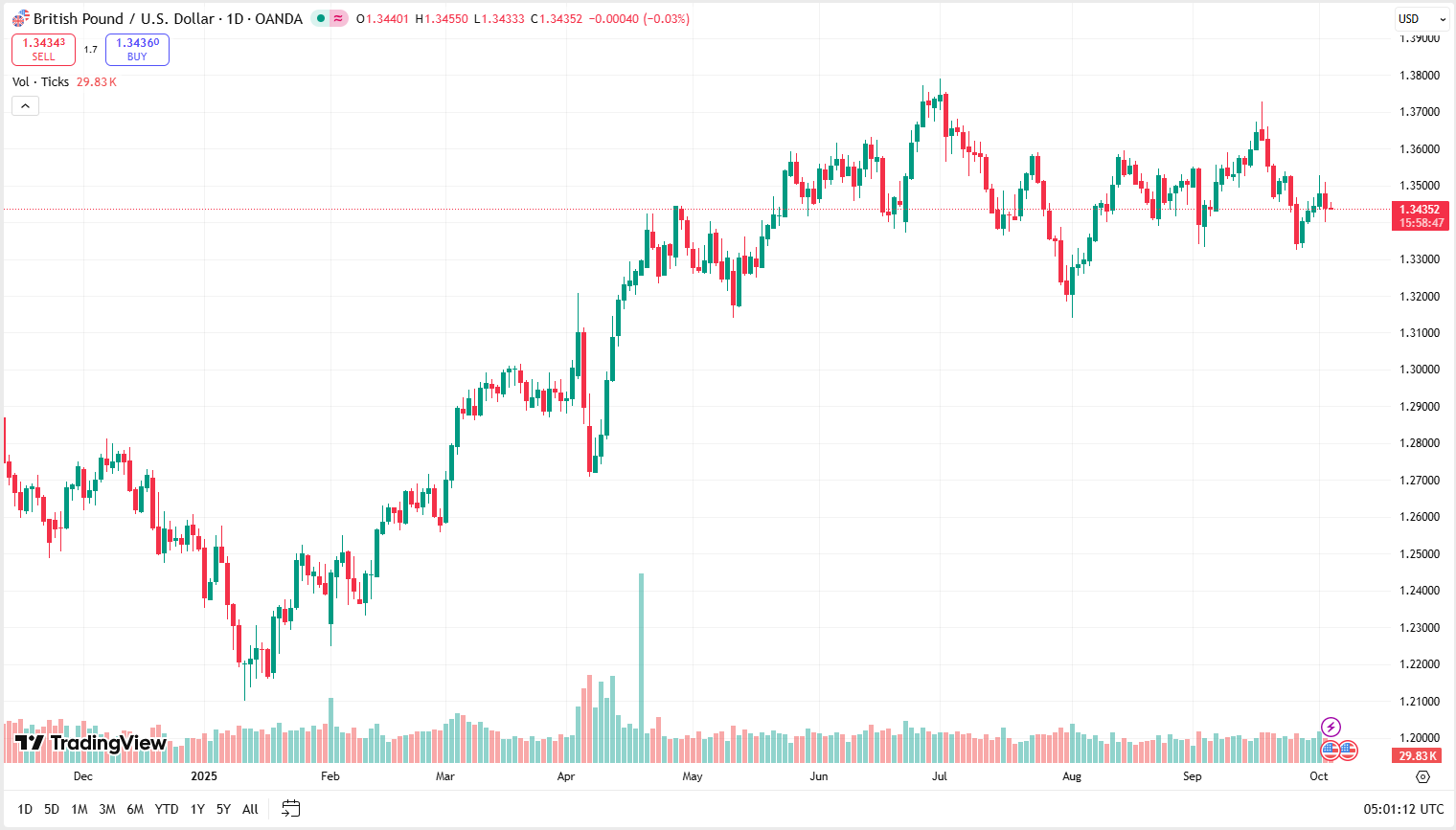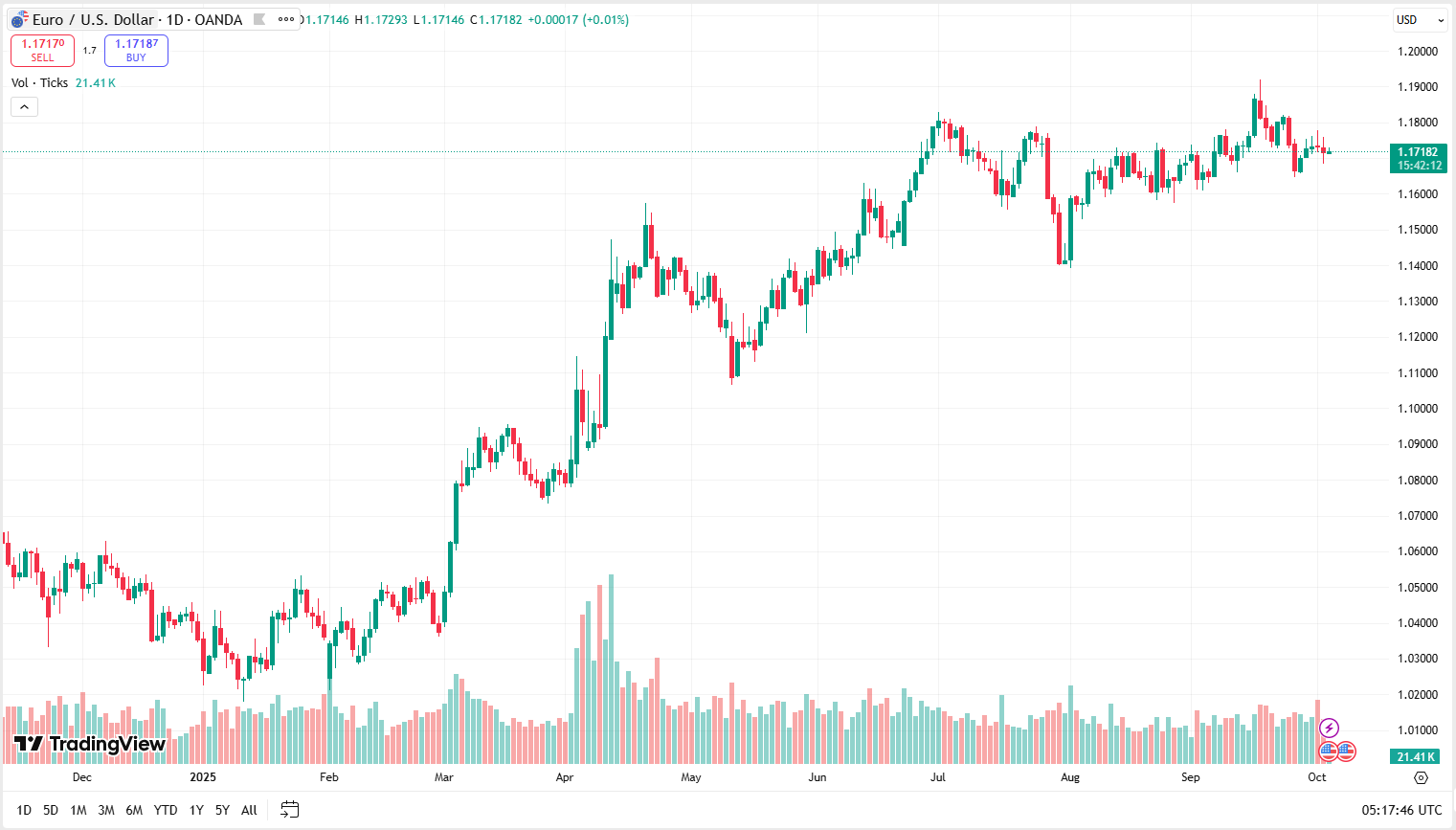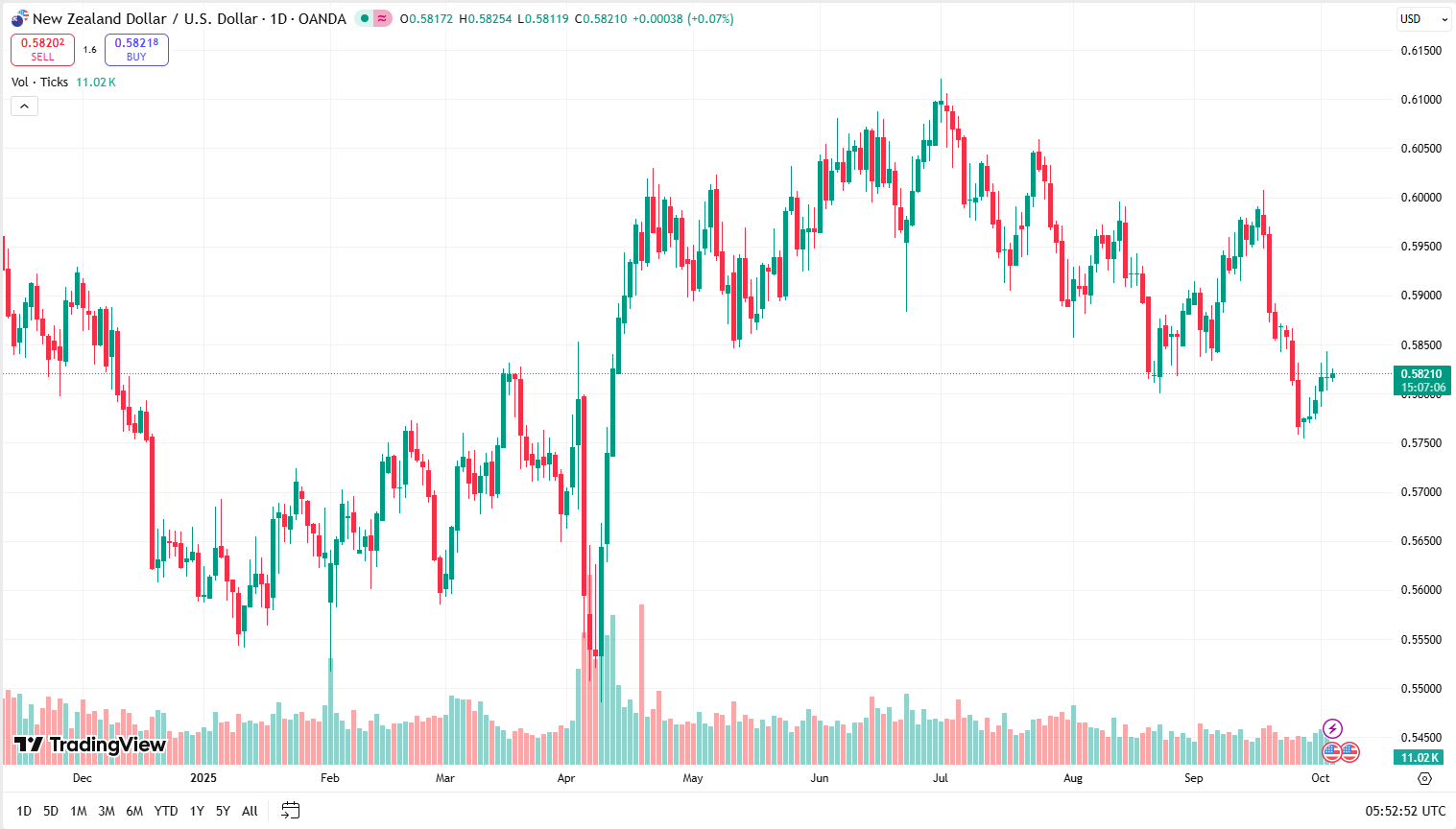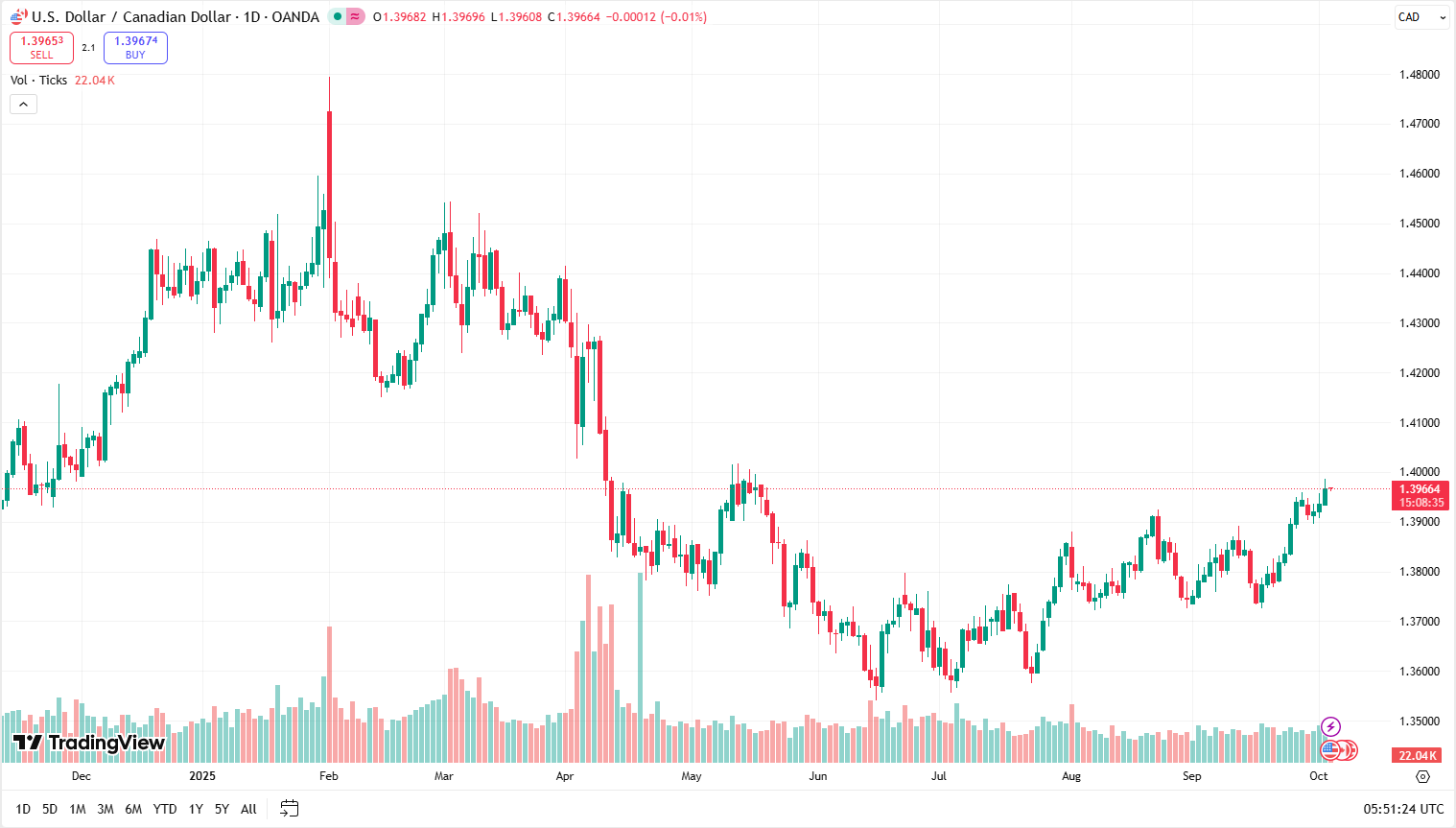GBP/USD Edges Higher Amid Dollar Weakness Concerns
The GBP/USD pair edged higher and traded around 1.3435 in Friday’s Asian trading. The slight improvement in the pair is believed to have come as the US dollar is sold off again under the increased worries about the US labour market and the extended government shutdown. Market commentators point out that due to the delay in the Nonfarm Payrolls (NFP) report in September, while the federal government is closed, investors are left to look at other expected indicators, such as the ISM Services PMI and the final S&P Global Services PMI. Those figures may provide additional information about the health of the US economy in the slowing rate of job creation.
Market commentators point out that the softer labour market environment has strengthened market anticipation of further Federal Reserve (Fed) easing. The CME Fed Watch tool indicates that traders have now virtually priced in a 25 basis point rate cut at the next Fed policy meeting, which would reduce the target range to 3.75%-4.00. Analysts anticipate that although conditions of declining rates typically undermine the dollar, the safe-haven demand due to the US fiscal uncertainty has capped the downside, thus making the Greenback medium-term prognosis somewhat ambivalent.
Market reports point out that the messaging of the Bank of England (BoE) is not consistent on the UK side. Deputy Governor Sarah Breeden, has recently warned about keeping the rates high too long, noticing risks to the economic activity, Clare Lombardelli noted the risk of underestimating inflation shocks. These are conflicting signals that are holding back faith in the longer term direction of the pound, though briefly boosted by the softer US dollar.
Analysts indicate that the GBP/USD pair may still be held by low-key US data and Fed rate-cut expectations in the short-term. Nonetheless, the medium-term risks associated with a policy difference of the BoE along with some uncertainty regarding the trends of UK inflation can put some pressure on the overall performance of sterling. Analysts indicate that inbound US service-sector data and events surrounding the government shutdown will continue to be major price action precipitants in the near term.

EUR/USD Steadies as Traders Await Key Data
The EUR/USD pair stayed steady to trade near 1.1720 in Friday’s Asian trading, following two consecutive days of losses. The consolidation is thought to be a display of pessimistic market sentiment before some important Eurozone data, as traders await the publication of HCOB Manufacturing and Services PMI readings and the Eurozone Producer Price Index (PPI). These numbers would offer a clue on the growth pace of the region, as well as the inflation pressures, both of which are paramount in developing expectations on the European Central Bank (ECB) policy position.
Market reports note that Thursday’s remarks by ECB policymaker Martins Kazaks contributed to the even-handed tone, though Kazaks said the prevailing interest rate was very suitable and it would not be reduced in the near future. He further highlighted high uncertainty, which stressed the data-dependent position of the ECB. This has helped to keep the euro in the holding position as traders balance between incoming macroeconomic indicators and the guarded attitude of the central bank.
Meanwhile, the US dollar has been defended because the market players are minimizing fears of the current shutdown of the US government. The interruption has also postponed the issue of the release of vital US labour market data, such as September Nonfarm Payrolls (NFP) report leaving investors to depend on alternative indicators. The anticipated ISM Services PMI and final S&P Global Services PMI would be carefully tracked to indicate underlying economic resilience. Weak data may support hopes of less vigorous U.S. growth pace.
Market reports point out that the outlook of the Fed is already dovish on the market prices and the CME FedWatch Tool has already reported about a 97% chance of a price decrease in October and more than 90% of another decline in December. The dollar is faced with medium-term negative risks in this dynamic. In the case of EUR/USD, close support at the level of 1.1700 is under attention, and long-term growth is limited by weak Eurozone fundamentals. Analysts indicate that the balance between Eurozone growth indicators and US macro data would determine the outlook of the pair, and short-term consolidation is likely, but medium-term risks are skewed towards a new volatility.

NZD/USD Struggles Near Resistance Amid Mixed Drivers
The NZD/USD pair traded above the 0.5800 handle with a firmer tone in Friday’s trading hours, after a volatile midweek performance. It is believed that although the pair came out of a multi-month trough in the 0.5700s last week, it still has resistance below the 200-day Simple Moving Average (SMA) and one-week high reached on Thursday. This is a technical obstacle that highlights the conflict between short-run purchasing interest and more sweeping crosswinds of US dollar strength.
Market reports point out that the greenback recovered to regain a fresh demand after plunging to a one week low on the basis of the Fed rate cuts later this year expectations. As two declines in the cost of borrowing are mostly already priced in, any change in the US data trend may strengthen or undermine this perspective. The anticipated US nonfarm payrolls and ISM services PMI releases would be closely tracked by traders, whose weak outcomes would put a strain on the dollar, which will provide additional relief to the Kiwi. On the other hand, US labour market figures may limit the growth of NZD/USD due to resilience.
Market commentators point out that sentiment on the New Zealand side is tainted by the expectation of additional easing by the Reserve Bank of New Zealand (RBNZ). Increasing bets of further rate cuts constrain interest in the NZD even as the global risk-on setting, evident in equity market returns, underpins risk-sensitive holdings. This is the mismatch of local expectations regarding monetary policy with external market forces which exposes the currency to the general change of investor sentiment.
Analysts indicate that the NZD/USD pair is generally expected to post the first weekly increase in three weeks, yet the medium-term picture is not very optimistic. Market commentators point out that although a weak US dollar and sanguine risk appetite provide low-term encouragement, the dovishness of the RBNZ and imminent US data risks might limit the upside. Bullish momentum must be affirmed by a sustained break above the 200-day SMA, and renewed demand in the dollar can soon take the pair to the mid-0.5700 support area.

USD/CAD Steadies Near Highs Amid Policy Uncertainty
The USD/CAD pair traded near 1.3960 in Friday’s Asian session, holding just below the five-month high of 1.3986 reached in the previous session. It is believed that the modest pullback indicates a stop to the recent ascent of the US dollar but sentiment remains widely on the greenback as merchants concentrate on macroeconomic uncertainty with the current US government shutdown. The political stalemate seems to have not yet put a dent on market participants, although postponement of major US economic releases, such as the September Nonfarm Payrolls (NFP) report, has put a possible damper on near-term positioning.
Market reports point out that the short-term focus is on scheduled US data, with the ISM Services PMI and last S&P Global Services PMI. Analysts indicate that these releases may provide new directional signals, especially since they are leading indicators of business activity and labour market conditions. The labour market has been central to the expectations of policy and recent weakness has strengthened the argument of additional monetary easing by the Fed. The CME FedWatch tool has estimated a 97% chance of rate cut in October and over 90% chance of further rate cut in December which has put USD at the mercy of any negative surprises of economic performance.
Market commentators indicate that on the Canadian side, sentiment is weighed down by soft domestic data. The latest S&P Global Manufacturing PMI fell to 47.7 in September, marking its eighth straight month in contraction. Weakness in new orders and output highlights ongoing headwinds for the Canadian economy, reinforcing expectations that the Bank of Canada (BoC) may continue easing after its September rate cut. Policymakers have kept the door open for further reductions if downside risks persist, which limits CAD’s ability to benefit even as oil prices remain relatively supportive.
Analysts indicate that the USD/CAD pair retains a constructive short-term bias while holding near multi-month highs, with support seen at 1.3920 and resistance at 1.3985/1.4000. The near-term trajectory would depend on scheduled US services data, though medium-term risks include both a deeper US slowdown and further easing from the BoC. This dynamic leaves the pair vulnerable to shifts in relative policy expectations, even as immediate momentum favours the US dollar.



 English
English 



































































































